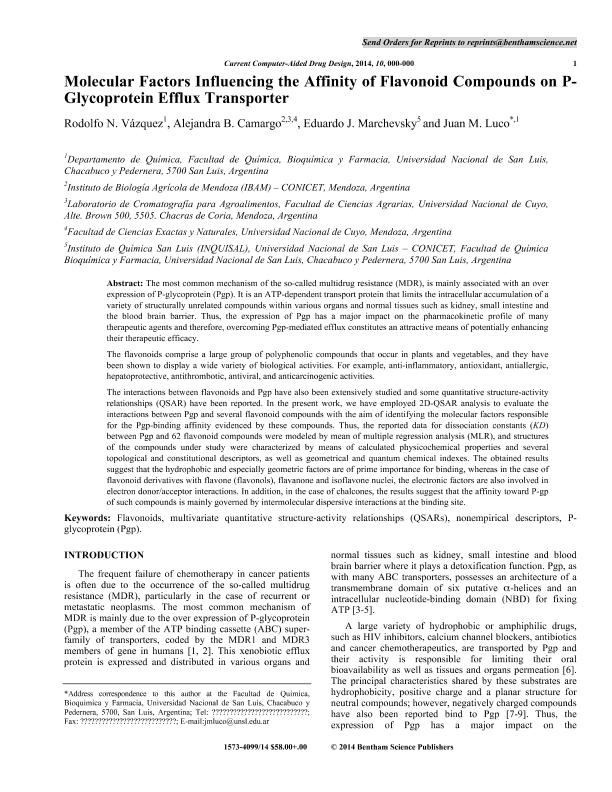Artículo
Molecular Factors Influencing the Affinity of Flavonoid Compounds on PGlycoprotein Efflux Transporter
Fecha de publicación:
10/2014
Editorial:
Bentham Science Publishers
Revista:
Current Computer-aided Drug Design
ISSN:
1573-4099
Idioma:
Inglés
Tipo de recurso:
Artículo publicado
Clasificación temática:
Resumen
The most common mechanism of the so-called multidrug resistance (MDR), is mainly associated with an over expression of P-glycoprotein (Pgp). It is an ATP-dependent transport protein that limits the intracellular accumulation of a variety of structurally unrelated compounds within various organs and normal tissues such as kidney, small intestine and the blood brain barrier. Thus, the expression of Pgp has a major impact on the pharmacokinetic profile of many therapeutic agents and therefore, overcoming Pgp-mediated efflux constitutes an attractive means of potentially enhancing their therapeutic efficacy. The flavonoids comprise a large group of polyphenolic compounds that occur in plants and vegetables, and they have been shown to display a wide variety of biological activities. For example, anti-inflammatory, antioxidant, ntiallergic, hepatoprotective, antithrombotic, antiviral, and anticarcinogenic activities. The interactions between flavonoids and Pgp have also been extensively studied and some quantitative structure-activity relationships (QSAR) have been reported. In the present work, we have employed 2D-QSAR analysis to evaluate the interactions between Pgp and several flavonoid compounds with the aim of dentifying the molecular factors responsible for the Pgp-binding affinity evidenced by these compounds. Thus, the reported data for dissociation constants (KD) between Pgp and 62 flavonoid compounds were modeled by mean of multiple regression analysis (MLR), and structures of the compounds under study were characterized by means of calculated physicochemical properties and several topological and constitutional descriptors, as well as geometrical and quantum chemical indexes. The obtained results suggest that the hydrophobic and especially geometric factors are of prime importance for binding, whereas in the case of flavonoid derivatives with flavone (flavonols), flavanone and isoflavone nuclei, the electronic factors are also involved in electron donor/acceptor interactions. In addition, in the case of chalcones, the results suggest that the affinity toward P-gp of such compounds is mainly governed by intermolecular dispersive interactions at the binding site.
Archivos asociados
Licencia
Identificadores
Colecciones
Articulos(IBAM)
Articulos de INST.DE BIOLOGIA AGRICOLA DE MENDOZA
Articulos de INST.DE BIOLOGIA AGRICOLA DE MENDOZA
Articulos(INQUISAL)
Articulos de INST. DE QUIMICA DE SAN LUIS
Articulos de INST. DE QUIMICA DE SAN LUIS
Citación
Luco, Juan Maria; Vázquez, Rodolfo Nieto; Camargo, Alejandra Beatriz; Marchevsky, Eduardo Jorge; Molecular Factors Influencing the Affinity of Flavonoid Compounds on PGlycoprotein Efflux Transporter; Bentham Science Publishers; Current Computer-aided Drug Design; 10; 3; 10-2014; 250-258
Compartir




